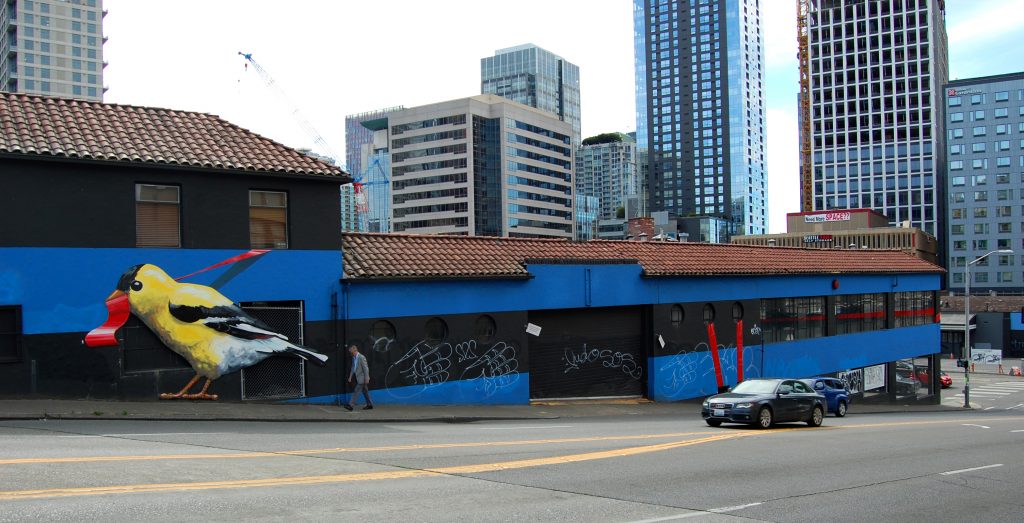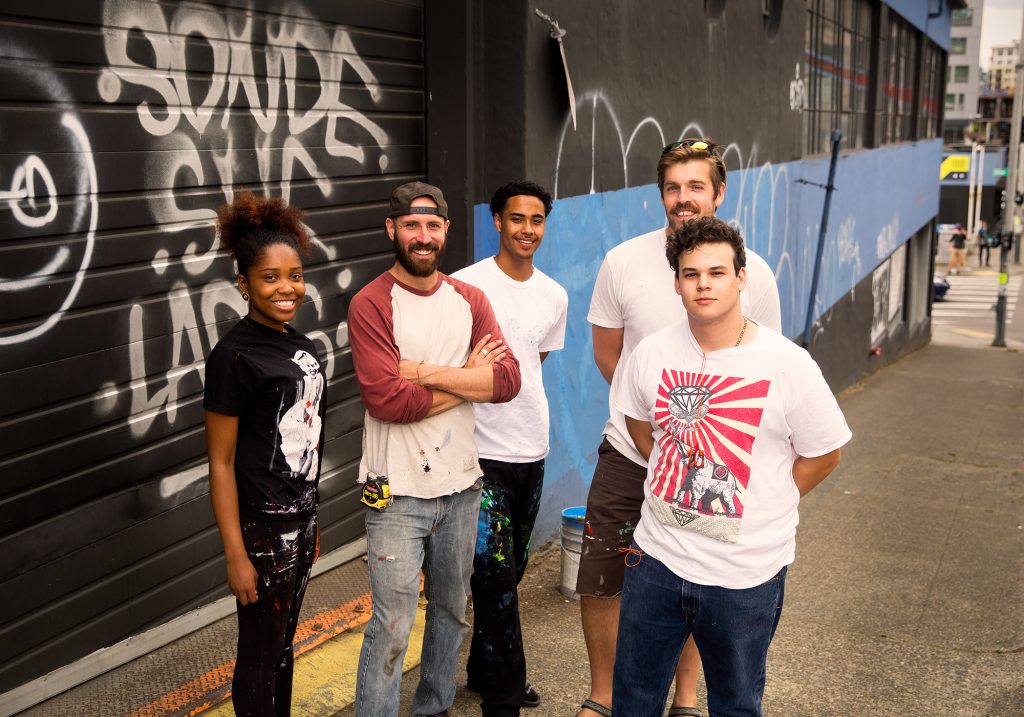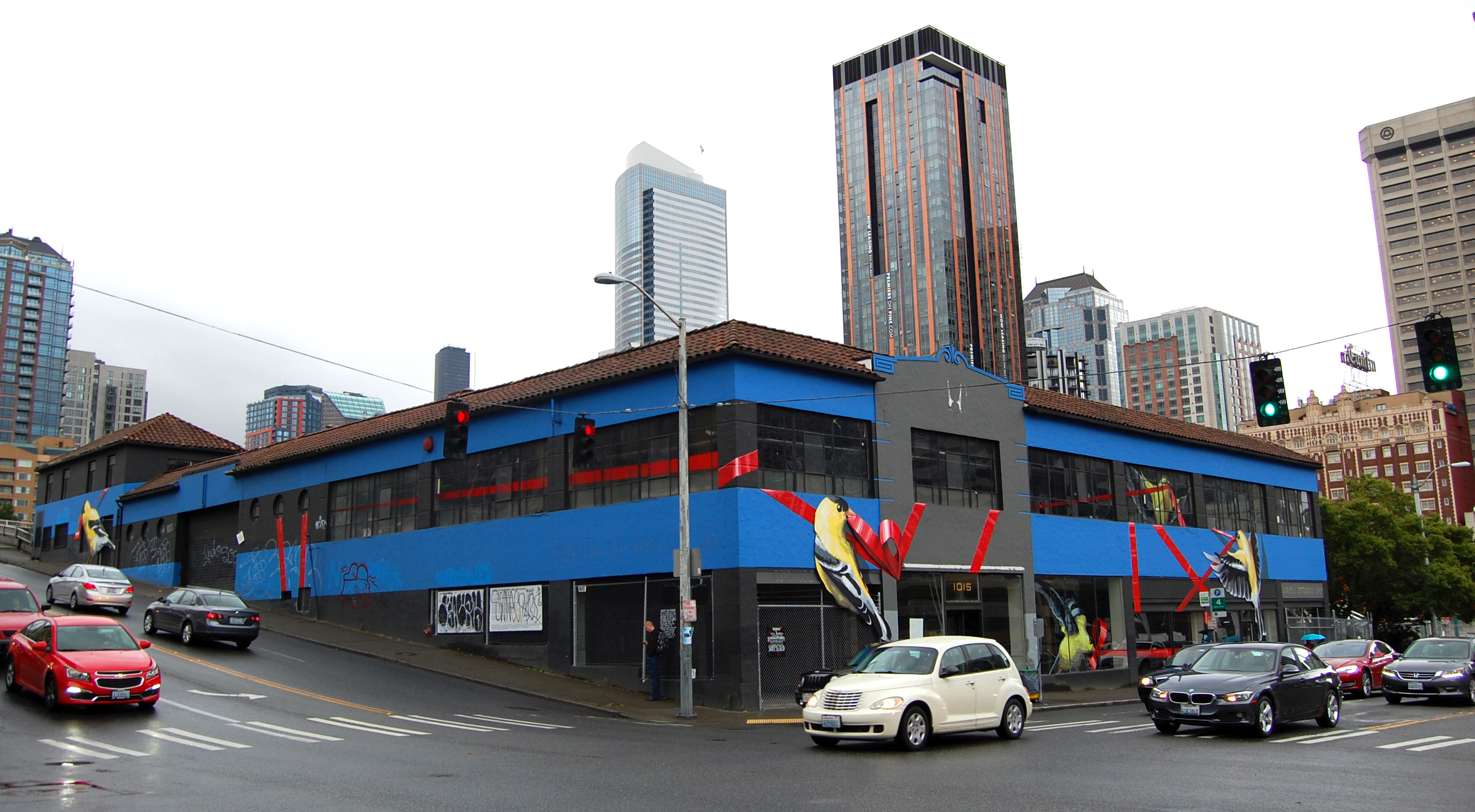Eventually, there will be yet another shiny new building. But at the corner of Boren and Olive, for now, there is a flock of goldfinches furiously wrapping (or unwrapping) a unique, unoccupied building in bright red ribbon.
Public art tells stories and presents ideas–but stories aren’t static and ideas aren’t objects. This is why temporary art is so valuable. It plays a role in the evolving narrative of communities, rather than attempting to just speak for, or to, those communities. Buildings will continue to be torn down and replaced, but it’s what exists in our collective hearts and minds, not what stands on our streets, that defines who we are.
Along with the committed help of Urban ArtWorks, the Pine Street Group, and the Washington State Convention Center, I created Ribbon, a mixed media mural, on the old Honda dealership at the downtown intersection of Boren and Olive. The work will live there until the building is torn down at some point in the next two years. It will then be replaced by a billion-dollar expansion of the Washington State Convention Center.
With projects like this, I’m often asked how I feel about the work being temporary. In my mind, my job is not to make objects as much as it is to present ideas, making the duration of the work less important than it’s message. And in the case of Ribbon, I think the eventual fate of the site plays directly into the hands of the piece’s narrative.

Perhaps these birds are trying to decorate the building in an attempt to save it from demolition. Perhaps they are preparing it for demolition, either by beautifying it for its final days or taping it off to prevent unauthorized entry. Perhaps they’re pulling ribbon from its bowels, salvaging what they can before the big machines continue their parade through town and bury the ribbon in rubble. Are they collaborating or are they clashing? Whichever narrative you choose (and feel free to consider others), each describes a reaction to looming change and highlights the importance of communication, foresight, hard work, and teamwork; all of which are paramount in being part of a community.
This project began when a friend of mine, Michael Archambault, from the Capitol Hill Community Council thought to reach out to the Washington State Convention Center to see if they would consider using temporary art to activate the old Honda site. He graciously involved me in the conversation and we were thrilled to find that the Convention Center was excited by the idea. The Pine Street Group, which is heading up the expansion project, invited Urban ArtWorks to join the project as well, providing some extra hands and hearts. I had just finished another downtown project with Urban ArtWorks and we were both looking forward to future collaborations. Turns out, we didn’t have to wait long.
Urban ArtWorks employs, trains, and mentors groups of adjudicated youth through the creation of public art–undoubtedly, you’ve seen their work around town. Through their programs, they provide teens ages 14-18 the opportunity to work hard, learn about art and their community, and prepare for the next steps in their lives. I first connected with Kathleen Warren, Urban ArtWorks’ Director, when I moved to Seattle two years ago, and was struck by both the mission and phenomenal success of the organization. The work that they’re doing for their teens as individuals, as well as the Seattle community as a whole, is really something special.

As for me, the ultimate goal of my work is to put surprising, playful, and thought-provoking work in the public realm, in the form of murals, public sculptures, and urban interventions. I like the idea of art being discovered, as opposed to being sought out. To me, the work speaks more truthfully when it exists in the context of every day life.
In Ribbon, the building isn’t merely a canvas, but an active part of the work, allowing viewers to imagine similar stories playing out in other locations at other times. It’s my hope that even after the goldfinches have moved along, the building has been demolished, and construction has begun on the Convention Center’s expansion, we can remember how much that bright red ribbon meant to those hardworking goldfinches. Of course, these are the lofty dreams of a hopeful artist. If in the end all it does is makes a few people smile while they sit in rush hour traffic, I’ll take that too.
Will Schlough is an artist living and working in Seattle, Washington. The ultimate goal of his artistic practice is to put surprising, playful, and thought-provoking work in public spaces where it can be experienced and enjoyed by an expanded audience. View his work at willschlough.com.



